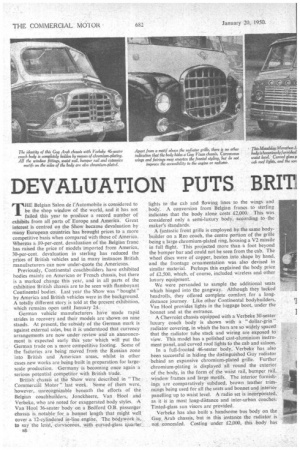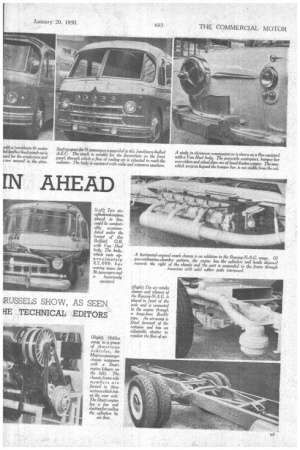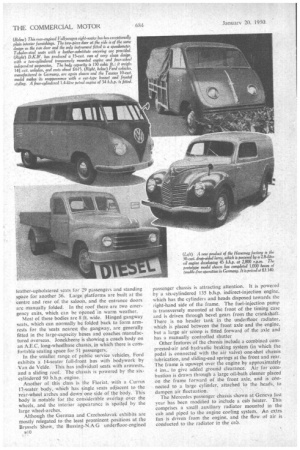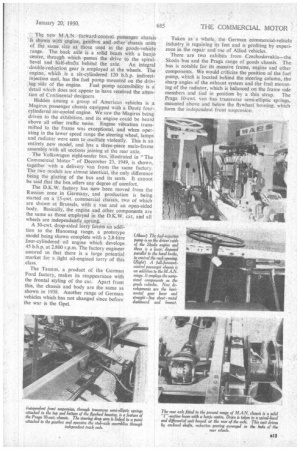DEVALUATION PUTS BRIT IN AHEAD
Page 42

Page 43

Page 44

Page 45

If you've noticed an error in this article please click here to report it so we can fix it.
THE Belgian Salon de l'Autornobile is considered to be the shop window of the world, and it has not failed this year to produce a record number of exhibits from all parts of Europe and America. Great interest is centred on the Show because devaluation by many European countries has brought prices to a more competitive basis when compared with those of America. Whereas a 10-per-cent, devaluation of the Belgian franc has raised the price of models imported from America, 30-per-cent. devaluation in sterling has reduced the prices of British vehicles and in many instances British manufacturers can now under-quote the Americans.
Previously, Continental coachbuilders have exhibited bodies mainly on American or French chassis, but there is a marked change this year, and in all parts of the exhibition British chassis are to be seen with flamboyant Continental bodies. Last year the Show was " bought " by America and British vehicles were in the background. A totally different story, is told at the present exhibition, which remains open until January 24..
German vehicle manufacturers have made rapid strides in recovery and their models are shown on nine stands. At present, the subsidy of the German mark is against external sales, but it is understood that currency arrangements are now under review and an announcement is expected early this year which will put the German trade on a more competitive footing. Some of the factories are being moved from the Russian zone into British and American areas, whilst in other cases new works are being built in preparation for largescale production. Germany is becoming once again a serious potential competitor with British trade.
British chassis at the Show were described in "The Commercial Motor" last week. Some of them were, however, unrecognizable beneath the efforts of the Belgian coachbuilders, Jonckheere, Van Hool and Verbeke, who are noted for exaggerated body styles. A Van Hool 36-seater body on a Bedford O.B. passenger chassis is, notable for a bonnet length that might well cover .a 12-cylindered in-line engine. The bodywork is to say the least; curvaceous, with curved-glass quarter,
Ea lights to the cab and flowing lines to the wings and body: A conversion from Belgian francs to sterling indicates that the body alone costs £2,000: This was considered only a semi-luxury body, according tothe maker's standards.
A fantastic front grille is employed by the same bodybuilder on a Reo coach, the centre portion of the grille being a large chromium-plated ring, housing a V2 missile in full flight. This projected more than a foot beyond the bumper bar and could not be seen from the cab. The wheel discs were of copper, beaten into shape by hand, and the frontage ornamentation was also devised in similar material. Perhaps this explained the body price of £2,500, which, of course, included wireless and other luxury equipment.
We were persuaded to sample the additional seats which hinged into the gangway. Although they lacked headrolls, they offered complete comfort for a longdistance journey. Like other Continental bodybuilders, Van Hool provides lights in the luggage boot, under the bonnet and at the entrance.
A Chevrolet chassis equipped with a Verbeke 30-seater luxury coach body is shown with a " dollar-grin " radiator covering, in which the bars are so widely spaced that the radiator tube stack and wiring are exposed to view. This model has a polished cast-aluminium instrument panel. and curved roof lights to the cab and saloon.
In a full-fronted 46-seater body, Verbeke has also been successful in hiding the distinguished Guy radiator behind an expansive chromium-plated grille. Further chromium-plating is displayed all round the exterior of the body, in the form of the waist rail, bumper rail. window frames and large motifs. The interior furnishings are comparatively subdued, brown leather trimmings being used for all the seats and bonnet and interior panelling up to waist level. A radio set is incorporated, as it is in most long-distance and inter-urban coaches. Tinted-glass sun visors are provided.
Verbeke has also built a handsome bus body on the Guy, Arab chassis, but in this instance the radiator is not ..concealed. Costing under £2,000, this body 'has
leather-upholstered seats for 29 passengers and standing space for another 36_ Large platforms are built at the centre and rear of. the saloon, and the entrance doors are manually folded. In the roof .there are two emergency exits, which can be opened in warm weather.
Most of these bodies are 8 ft. wide. Hinged gangway seats, which can normally be folded back to form armrests for the 'seats nearest the gangway, are generally fitted in the large-capacity buses and coaches manufactured overseas. Jonckheere is showing a coach body on an A.E.C. long-wheelbase chassis, in which there is comfortable seating space for 51 passengers.
In the smaller range of public service vehicles, Ford exhibits a 14-seater full-front bus with bodywork by Van de Velde. This has individual seats with armrests, and a sliding roof. The chassis is powered by the sixcylindered 90 b.h.p. engine.
Another of this class is the Floriat. with a Currus 17-seater body, which has single seats adjacent to the rear-wheel arches and downone side of the body. This body is notable for the considerable overlap over the wheels, and the interior appearance is spoiled by the large wheel-arches.
Although the German and Czechoslovak exhibits are mostly relegated to the least prominent positions at the Brussels Show, the Bussing-N.A G underfloor-engined
passenger chassis is attracting attention. It is powered by a six-cylindered 135 b.h.p. indirect-injection engine, which has the cylinders and heads disposed towards the right-hand side of the frame. The fuel-injection pump is transversely mounted at the front of the timing case and is driven through bevel gears from the crankshaft. There is no header tank in the underfloor radiator, which is placed between the front axle and the engine, but a large air scoop is fitted forward of the axle and has a manually controlled shutter Other features of the chassis include a combined compressed-air and hydraulic braking system (in which the pedal is connected with the air valve) one-shot chassis lubrication, and sliding-end springs at the front and rear. The frame is upswept over the engine by approximately 4 ins., to give added ground clearance. Air for combustion is drawn through a large oil-bath cleaner placed on the frame forward of the front axle, and is connected to a large cylinder, attached to the heads, to dampen air fluctuation.
The Mercedes passenger chassis shown at Geneva last year has been inodilied to include a cab heater. This comprises a small auxiliary radiator mounted in the cab and piped to the engine cooling system. An extra fan is driven from the engine, and the flow of air is conducted to the radiator in the cab.
The new M.A.N. forward-control passenger, chassis is shown with engine, gearbox and other chassis units of the same size as those used in the goods vehicle range. The back axle is a solid beam with a banjo centre, through which passes the drive to the spiral bevel and half-shafts behind the axle. An integral double-reduction gear is employed at the wheels. The engine, which is a six-cylindered 120 b.h.p indirectinjection unit, has the fuel pump mounted on the driv
ing side of the engine. Fuel pump accessibility is a detail which does not appear to have received the attention of Continental-designers • Hidden among a group of American vehicles is .a Magirus passenger chassis equipped with a Deutz fourcylindered air-cooled engine. We saw the Magirns being driven to the exhibition, and its engine could be heard above all other traffic noise. Engine vibration transmitted to the frame was exceptional, and when operating in the lower speed range the steering wheel, lamps and radiator were seen to oscillate violently. This is an entirely new model, and has a three-piece main-frame assembly with all sections joining at the rear axle.
The Volkswagen eight-seater bus, illustrated in "The Commercial 'Motor" of December 23, 1949, is shown, together with a delivery van from the same factory. The two models are almost identiCal, the only difference being the glazing of the bus and its seats. It cannot be said that the bus,offers any degree-of comfort.
The D.K.W. factory has now been moved from the Russian zone in Germany, and production is being started on a 15-cwt. commercial chassis, two of which are shown at Brussels, with a van and an open-sided body. Basically, the engine and other components are the same as those employed in.the D.K.W. car, and all wheels are independently sprung.
A 30-cwt. drop-sided lorry forms an addition to the Hanomag range, a prototype model being shown complete with a 2.8-litre four-cylindered oil engine which develops 45 b.h.p. at 2,800 r.p.tn. The factory engineer assured us that there is a large potential market for a light oil-engined lorry of this class.
The Taunus, a product of the German Ford factory, makes its reappearance with the frontal styling of the car. Apart from this, the chassis and body are the same as shown in 1938. Another range of German vehicles which has not changed since before the war is the Opel. Taken as a whole, the German commercial-vehicle industry is regaining its feet and is profiting by experience in the repair and use of Allied vehicles.
There are two exhibits from Czechoslovakia—the Reda bus and the Praga range of goods chassis. The bus is notable for its massive frame, engine and other components. We would criticize the position of the fuel pump, which is located behind the steering column, the sharp angles of the exhaust system and the frail mounting of the radiator, which is balanced on the frame side members and tied in position by a thin strap. The Praga 10-cwt. van has transverse semi-elliptic springs, mounted above and below the flywheel housing, which form the independent front suspension.




















































































